One of my favorite things about India is the vast number of festivals and holy days. Each festival or holy day has bright colors, delicious food, parades, parties, and pujas. Just in case you forgot, a puja is a series of prayers and rituals you do to honor God. The Hindu religion has millions of gods; each god is a facet of the one big God. Each believer chooses his own personal gods as well as performing puja for major gods.
One of my personal favorites is the Goddess Lakshmi; the goddess of wealth and money. Her special day is the same as my birthday, August 24th! (Tom says “Why am I not surprised?”). Lakshmi Puja is a special festival for women. I went to my friend Prathiba’s for her puja. We all wear a beautiful saree, have nice food, chat, and admire the hostess’s puja room. She will have decorated her statue of Lakshmi with beautiful flowers and fabrics. Here I am on my way to her place.

The next big festival is for Ganesha. I wrote about him is my very first blog entry and a little bit again on September 28 when Barbara was here.
The next fun fest comes up toward the end of October. This festival is called Dasara. It is a religious as well as a social festival, just one more occasion to party! In our state, Karnataka, we celebrate Dasara by worshipping things we use in daily life or our work life. I have been encouraged to do puja for my piano, but have not done it so far. For some reason, the most important thing to worship is our cars. We have a huge fun time smashing melons, lemons, and coconuts to do puja for them.
People also decorate their cars, cycles, and trucks with flowers, balloons, banana leaves, colored paper and so on. You can see our car and rickshaw decorated above.
Our friends and neighbors Prathiba and Yogesh and their two daughters host a big puja fest for the men that work for them. P and Y are real estate agents who employ a huge number of garden men, drivers, carpenters and plumbers that take care of the properties they’re responsible for.
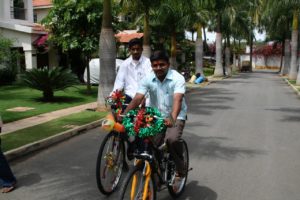
Most of the workmen have bikes or two-wheelers.All these men bring their vehicles to P and Y’s place. Each vehicle is lovingly decorated. Here are a few examples:
As soon as you get your new vehicle, you perform a puja for it. You can see a home ceremony in the blog entry “The Three-Wheeler”. However, if you get a new car or truck, you really should go to the temple and have the priest perform the puja.
It is unbelievable, but we had not yet done a proper car puja on our Honda CRV. Babu and Tom had gone to the temple on several occasions, but it was closed or the priest was sick or the line was long or something. This year, we decided to go to the temple and have a proper puja done on our car. Dasara is an especially good time to go. We were positive the temple would be open and the priest would be there. Here’s the temple just a few kilometers from our place.
During the morning, when we were having fun with our neighborhood puja, the sun shone and the day sparkled. This is the monsoon season, however, and our luck didn’t last into the afternoon. Here we are all crowded into the temple praying. Usually, you can stand outside, but it was too wet.
You can’t wear your shoes in the temple either—what a mess. Parents held most of the really little kids, but the other ones were wet and wiggly.
The next couple pictures show the lovely decorations on the cars. It was really impressive, almost like a Rose Bowl parade! 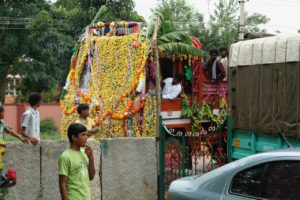
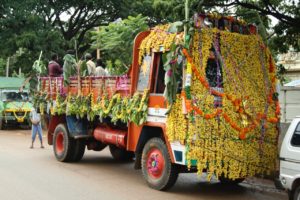
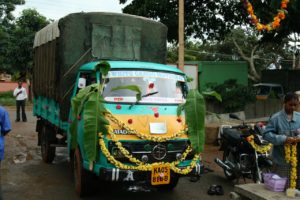
Here is the priest and his apprentice. The young boy will serve as an apprentice until he is about 18. He will then be able to do some of the pujas himself, but will have to attend a special school to complete the training.
The priest puts a design drawn in turmeric on our car to show we have prayed and done our car puja.
The priest burns the final offering to complete the puja. Everyone brings some fruits, flowers, and a little money for the puja.
These gifts are given to the god Ganesha. The priest gives some of the offerings back to the people, and some he keeps for himself. We put our money on the offering plate as well. The priest keeps the money to support the temple and priests. I’m not sure how all the temples raise money and pay priests. Babu tells me the larger temples have committees and governors, but some small ones are maintained privately or with offerings.
Except for festivals, Hindus don’t have a Holy Day as Christians, Muslims, and Jews have. There is no special time for services either. They pray daily as much or as little as they like. Most people have a puja room or shrine at home and don’t stop in at a temple, but many people go to the temple every day. Here are all the offerings collected so far.
When the puja is complete, you put a statue of Ganesha on the dashboard of your car. Babu chose a really nice Ganesha. He buys a small garland of jasmine every day or so and drapes it around the statue.
While driving around today, I saw two things that made me really happy. One is this lady selling toys. Isn’t that just great! I want ALL the windmills. I want to be that lady so I can have them all flap in the wind at once!
The other thing I really like is this house all lit up and smiling in the rain. The house is just across the street from our compound and next to Sanjeev the Flower Wallah’s shop. The house usually isn’t much to look at, but today it is just beautiful.
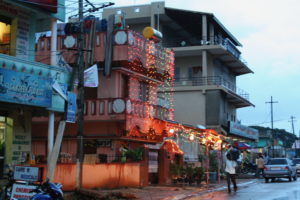
I’m sure I made tons of errors in my explanations of Hindu beliefs and rituals. Make a comment and set me straight!

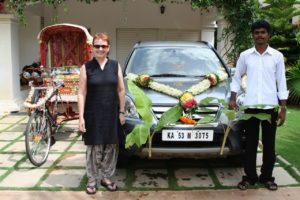
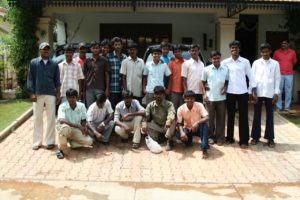
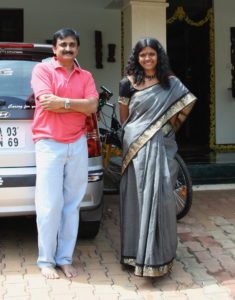
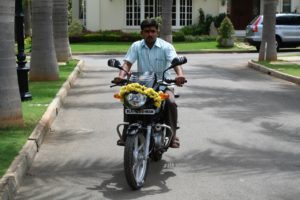
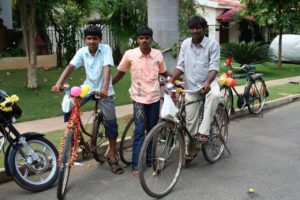

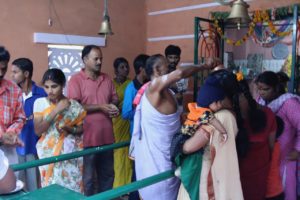
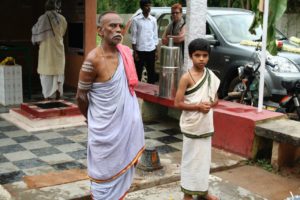
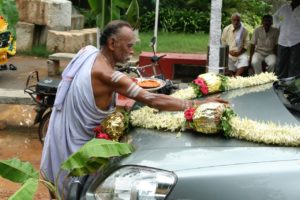
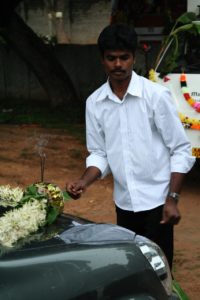
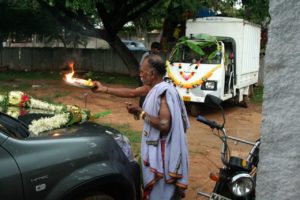
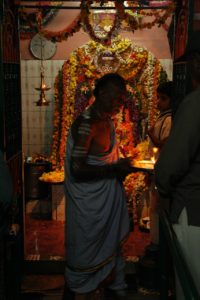
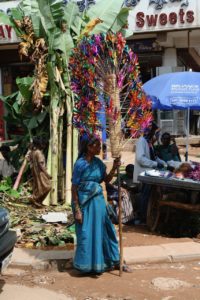



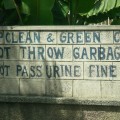
No comments yet.